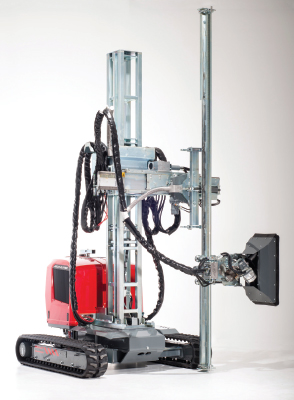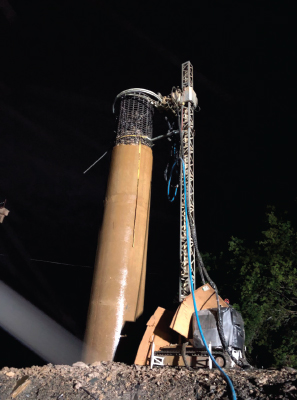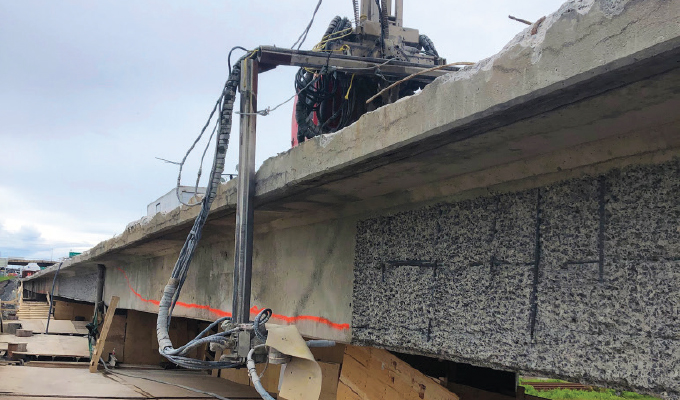By Keith Armishaw
For decades, road and bridge repair contractors have relied on the power and precision of Hydrodemolition robots to increase efficiency for concrete removal and surface preparation applications. Traditional methods of bridge deck repair took hours of manual labor using handheld water jetting equipment or handheld pneumatic tools. By switching to Hydrodemolition robots, contractors are able to keep operators out of harm’s way, reducing injuries and increasing efficiency.
Hydrodemolition uses high-pressure water jets as powerful as 40,000 psi manipulated by a robot to remove layers of deteriorated and damaged concrete. The results are superior bonding and extended structure lifespans, as well as increased safety and productivity. A Hydrodemolition robot’s high-pressure water jet removes concrete by widening existing pores and micro cracks in the weakened structure. Since the process is impact-free, there are no vibrations, and therefore less risk of microfractures. Hydrodemolition also cleans and descales rebar without damaging it. And with a production rate of up to 25 times faster than hand lances, it’s no wonder contractors employ Hydrodemolition for bridge deck repairs, expansion joint replacements, and a number of other flatwork tasks.
But what if that same productivity could be harnessed for work in other areas, such as abutments and piers? With the right attachments, it can. Here are three Hydrodemolition attachments to maximize bridge repair efficiency.

1. EXTENSION KIT WITH ELBOW
When tasks extend beyond flatwork, contractors often resort to scaffolding and hand tools to reach surfaces on the girders, parapet, or under the edge of the bridge. An extension kit offers improved versatility by extending the Hydrodemolition robot’s reach 8.2 feet below the robot’s tracks. The extension kit allows for about a 13-foot working width—side to side and up and down—for a wider surface removal.
The addition of an elbow means not only can the Hydrodemolition robot reach higher, it can also bend to access hard-to-reach areas. In this way, an extension kit can be used for concrete removal or surface preparation on the side of a bridge or column while the robot remains on the deck—and there’s no need to dismantle the bridge railing. Additionally, the kit can be configured to allow removal of material from the underside of a bridge deck by reaching over the edge and aiming the cutting head upwards.
2. ROTATING TOOL FOR SURFACE PREPARATION
Pair the extension kit with a rotating tool with multiple water jets for efficient surface preparation and membrane removal in hard-to-reach places. These tools take advantage of the Hydrodemolition robot’s power—operating at up to 36,259 psi—to eliminate the need for hand lances and sandblasting while providing a superior bonding surface. With a rotating tool, contractors can easily achieve concrete surface preparation (CSP) values from 3 to 10.
Rotating tools clean, remove, and roughen concrete surfaces during bridge repair applications and can tackle rubber coatings, paint, rust, plastic, and other materials. Tools are available with up to 20 jets or nozzles and offer production speeds up to 1,500 square feet per hour, depending on application. They can be used anywhere the robot can reach, reducing the need for scaffolding and the use of hand tools.
As an alternative for sandblasting in surface preparation and paint removal on bridges, this method also eliminates dust pollution and there is no contaminated sand to dispose of.
Specialized surface preparation cutting heads are available from industry-leading manufacturers and can cover a surface diameter as wide as 14 inches for maximum productivity.

3. CIRCULAR CUTTING HEAD
A circular cutting head greatly increases efficiency for concrete removal on columns and pillars. Traditionally, repair and rehabilitation of these structures would take a fair amount of repositioning as crews with hand tools worked their way around, often on scaffolding. However, circular cutting heads incorporate two semi-circular pieces of track that wrap around pillars of any diameter to create a 360-degree ring. From there, a robotic cutting head is attached and “walks” around on a curved roller beam. The circular track and cutting head then move up and down using the robot’s mast. This process eliminates the need to reposition equipment or crew, saving significant time while providing ample power for concrete and material removal.
CLOSING THOUGHT
A Hydrodemolition robot and suite of attachments can reduce labor requirements, increase safety, and provide a better result than handheld tools—taking them far beyond flatwork.
About the Author:
Keith Armishaw is the business development manager for Aquajet’s North American subsidiary. He has more than 24 years of industry and leadership experience. Aquajet is known as the industry leader in hydrodemolition machines and solutions, both in terms of quality and volume. The company’s headquarters and production facilities are in Holsbybrunn, Sweden. For more, visit www.aquajet.se.
Modern Contractor Solutions, September 2021
Did you enjoy this article?
Subscribe to the FREE Digital Edition of Modern Contractor Solutions magazine.



